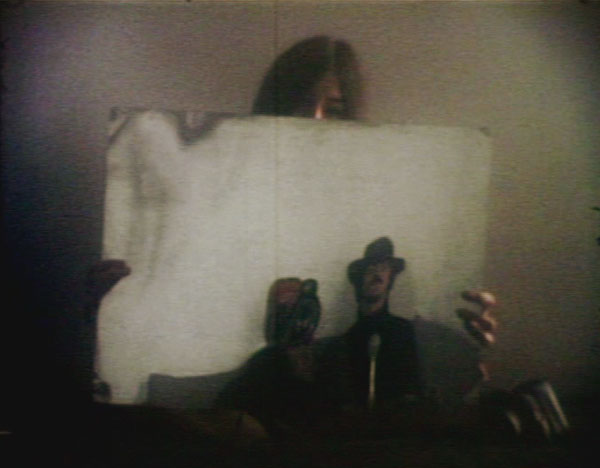
When Jim McBride made David Holzman’s Diary with L.M. Kit Carson in 1967, the personal documentary — the very genre the movie appears to mercilessly satirize — barely existed. The film introduces itself as the creation of its eponymous protagonist, a man so deeply in thrall to claims of cinematic truth that he begins keeping a film diary in the belief that his footage will reveal to him, as if by magic, the source of his existential crisis. Though he learns nothing, he persists, alienating his few remaining friends, until his equipment is stolen and he is forced to stop. The diary film that Holzman purports to be was not created to stand as the latest iteration of a flourishing trend, but as the reductio ad absurdum of Cinema vérité rhetoric. Rather than dampening the excitement around vérité filmmaking, which was never really the point anyway, David Holzman’s Diary instead announced the birth of a whole new documentary subgenre. Since Holzman, first-person non-fiction filmmaking, under the various guises of “personal documentary”, “diary film” or “autobiographical documentary”, has become one of the most popular forms of American independent cinema .
McBride himself was among the first to respond to his film’s implicit challenge, following it with two autobiographical mid-lengthers, My Girlfriend’s Wedding (1969), and Pictures from Life’s Other Side (1971), both of which screened at UnionDocs in January. The irony of McBride’s apparent reversal (the first of many in a career defined by counterintuitive decisions) is delicious enough to tempt reductionist interpretations of both Holzman and its successors, but the whole story is a little more complicated. Like all good satire, David Holzman’s Diary convincingly simulates many of the virtues of its target. It has remained relevant because of the possibilities its making suggests rather than the ones its mordant critique forecloses. And though it is appropriate to call My Girlfriend’s Wedding and Pictures From Life’s Other Side personal documentaries, the films do not much resemble the obsessive, solipsistic Holzman. Early in My Girlfriend’s Wedding, McBride appears on camera and re-introduces the Éclair 16mm camera that co-starred with Carson in online Holzman, but he is reflected in a mirror held by the film’s true subject: Clarissa Ainley, his then-girlfriend. The bulk of the movie’s purchase alligator 60-minute run time comprises a nearly unedited conversation with Ainley on the eve of her green card marriage. Narrating the events in her life that brought her from England to North America, it seems it is she rather than McBride who is desperate to find insight at 24 frames a second.
In rural England, Ainley’s life was constrained by the child she had as a teenager and by her conservative parents, whose sense of responsibility and propriety still governed her life. Finding herself pregnant again, she fled to Canada for an abortion before making her way to New York. The sexual revolution, and its promise of “dissociation from everything that has conditioned you” is what brought her here. About the other part of the revolution –the toppling of the political system responsible for much of that conditioning — she hasn’t much to say. Marriage is of course antithetical to her restless impatience with the old social arrangements, but it is the only path to U.S. citenzenship for her and her son. So rather than contaminate her feelings for McBride with the reactionary values of the old world, she has arranged a sham engagement with another man, the owner of a leftist publishing house.
The progress of Holzman turns on the growing discomfort of fictional filmmaker’s girlfriend with his invasive, compulsive documentation, but Ainley welcomes the camera’s attention. In her interactions with McBride and assistant cameraman Michael Wadley (who went on to direct Woodstock and, years later, Wolfen, a neglected classic of 80s expressionist horror), she has an easy performative manner. When she describes her life, she never seems disingenuous. Answering questions unrehearsed, she is alternately sharp and dippy, self-reflective and self-justifying, deep and shallow, evincing all the contradictions of a complex human being. In their conversation, Ainley and McBride betray few reservations about the marriage, but during the wedding itself, and its desultory little after-party, the mood becomes a little grim.
Any lingering sense of dissatisfaction is dispelled in the film’s coda, an explosive pixilated montage of images from McBride and Ainley’s mock honeymoon in California. Apart from the time covered in this punctuation mark, My Girlfriend’s Wedding is limited to the day of the ceremony, and the two days that bookend it, its spaces confined to a few interiors. When McBride received a commission from the AFI after My Girlfriend’s Wedding had been completed, he took the opportunity to document his life with Clarissa at a more expansive, leisurely pace. Pictures from Life’s Other Side finds the couple still together two years later, Ainley now pregnant with McBride’s child, and the couple joined by her older son Joe. The AFI money — which was not renewed for post-production costs after a change in the institution’s leadership left the filmmaker without support there — gave McBride an excuse to record the family’s move from New York to Northern California, merging the distinctly American personal documentary with another particularly American genre: the road movie.
Ainley is closer to co-director than star here, narrating the primitively animated passages that advance the story as they link up the vérite scenes taken by McBride in motels, roadside attractions, and from the window of his moving car. McBride himself becomes a more consistent onscreen presence, but it is Ainley’s son Joe who provides the film’s most memorable scenes, which find him trying to work out his place within his mother’s unconventional arrangement. He is sometimes affectionate towards McBride, but as the film progresses he is more frequently venomous, and it is never clear how much of his anger is fueled by unexceptional Oedipal longings, and how much by the particular alienation of his experimental rearing. Whatever sympathies you may hold for McBride and Ainley’s liberated domesticity, it is difficult not to feel sorry for the 8-year old dropped into the middle of it from another country, and harder still to avoid drawing a connection between his guardians’ open intimacy — which entails exposing Joe not only to casual nudity, but at least on one occasion, their foreplay — and the sexually graphic threats that constitute a part of Joe’s hostile campaign against McBride. Despite this, the tone of the film is altogether lighter and more whimsical than that of My Girlfriend’s Wedding, which is suffused with a free floating air of disappointment. The warmth of McBride’s home movie technique jostles against the disturbing nature of some the material, generating a friction electric with mixed emotions.
Next to the freewheeling, manic energy of David Holzman’s Diary, however, both of them look drab and inert. But Holzman is too articulate to be believed. The film traces its protagonist’s dissolution in frenzied strokes that align perfectly with his psychological trajectory. It suggests the possibility of an aesthetic mimesis that belies its skepticism about documentary, and marks it as an obvious forgery. Trained on one’s own life, the camera is a crude instrument. McBride captures swathes of his experience as one might try to catch fish with a burlap sack. A filmmaker depicting events in which he does not directly participate should be expected to refine the material to its essence, but McBride shares David Holzman’s desire to run his life through the analytic film projector (he is just less naive about the quality of the light it throws), and the relative formlessness of these films is inherent to their exploratory impetus. McBride’s chunky, undifferentiated construction respects the minute-to-minute banality of workaday life, and allows meaning to gather in the interstices between expression and action. There is no decisive moment, but an accumulation of indecisive ones. My Girlfriend’s Wedding Cheap and Pictures From Life’s Other Side are, of course, no more able than David Holzman’s Diary to provide an objective vantage on life as it is lived. But the unwieldy, digressive units from which McBride assembles these movies allow for more of its rhythms and textures than most, “vérite” or otherwise.
This indeterminate form perfectly molds the slack, hangdog face of early 1970s America. McBride’s films make good on autobiography’s implicit promise to reveal the general through the particular. When we join McBride and Ainley in My Girlfriend’s Wedding Order , they are both already wearied by the New Left’s failure to produce a second American revolution. Alone with Ainley on the evening of her wedding, McBride tells her: “It was a very upsetting experience and I’m not quite sure why. ” Some clues are available in the previous scene, which shows the wedding party dominated by Ainley’s new husband, a boorish Yippie clown whose politics seem to consist entirely of half-digested catch phrases and a macho militancy that only happens to have attached itself to the Left. By the time captured in Pictures from Life’s Other Side, they, like so many other young radicals, had transferred their utopian aspirations from the public to the private sphere. McBride finished editing the film in the same year that est began offering courses at San Francisco’s Jack Tar Hotel. The forlorn ambivalence that emanates from both films, and the self-questioning that must have prompted their making, echoes the wider cultural misgivings that met these developments.
As the program’s curator Jed Rapfogel put it during the post-screening discussion, these two films are made by someone who has thrown his life into the sexual revolution but left one foot out the door. For McBride, they are autopsies — he tips his hand with the title of the second film (the more upbeat one!), borrowed from a folk ballad that limns the inextricable association of image-making with death. But the films do more than rehearse the familiar story of 70s malaise. In McBride and, particularly in Ainley, we can locate the earnest craving for a freer, more equitable world that lay behind many of the 70s social experiments since discarded as the decadent and faddish excrement of 60s idealism. The world Ainley describes escaping in Cheap My Girlfriend’s Wedding refused to acknowledge the validity of her desires. In Pictures From Life’s Other Side, Ainley seems at peace with herself, having cast away the gnawing doubt she betrays in the prior film. And though the family’s dynamic is decidedly pre-feminist, in McBride she has found a partner as anxious as she to make a life that does not sacrifice autonomy for stability. Her efforts are not designed solely for personal fulfillment, but also to provide her son a more humane environment in which to develop. While Joe’s sullen outbursts make it obvious that his upbringing hasn’t been flawless, in most of the film he is livelier, happier, and more curious than he likely would have been had Ainley settled for a provincial English life with the clod who knocked her up.
Rich with surface detail, alive to broad cultural currents, and sensitive to human motivations noble and base, McBride’s mostly-forgotten personal films give concrete form to an era Baby Boomers are now more likely to recount as their own mythic Fall. It is a shame that they have never garnered the same attention as the more cynical Holzman, because while My Girlfriend’s Wedding and Pictures From Life’s Other Side are equally instructive about documentary’s limitations, they supplement that knowledge with all the unruly real life existence that a roll of 16mm film can bear, reminding us that great art is rarely produced by those who quietly accept that certain things are not possible. Cheap





